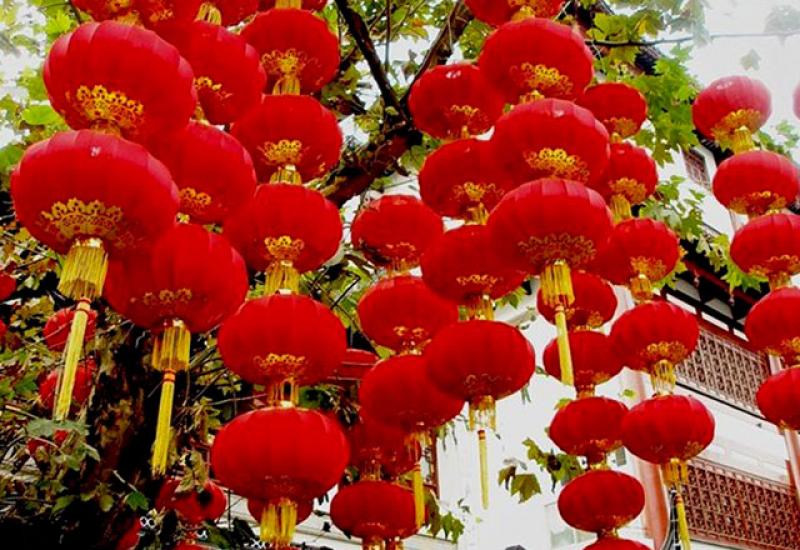Chinese New Year - Chun Jie, meaning Spring Festival is the most important holiday for the Chinese, it has been celebrated for over two thousand years. It falls on the first new moon of the first month of the year, between 12 January and 19 February. With the introduction of the Gregorian calendar this holiday came to be called "spring holiday", to distinguish it from the New Year on the Western style. In life Chun Jie is called "Nian" ( nian - means "year").
According to legend, Nian is a ferocious frightening monster with horns on his head, who lived in ancient China. All year it was in the depths of the sea, and only New Year's Eve crawled out of the water, broke into settlements where he ate cattle and destroyed people. Therefore, farmers were very afraid of him, and every year before the onset of the New Year with their families left the village and fled to the mountains to escape from the terrible beast Nian.
One day before the New Year, when the peasants Tao hua ("peach flower"), supporting the elderly, with children in the hands, were leaving the village, there came an old beggar with a mustache silver color. In one hand he held a cane in the other - bag.
At this time, some villagers covered the windows and closed the house, others collecedt things on the road, and others guided cattle, in other words, everyone was busy and everyone was worried, thus no one paid much attention to this old man. Only one woman gave him some food and began to persuade him to leave the village as soon as possible to avoid meeting with Nian. However, the grandfather smiled and said, "Let me stay in your house at night, and I will take away from the village this Nian."
The woman was surprised and looked at the old man, she noticed that the gray-haired man with a youthful face looked refreshed and strong, but still she urged him to escape with all of predatory Nian. But the old man stood his ground, and the woman had to go.
Around midnight Nian rushed into the village. This time he noticed that there was something wrong in the village, not as it was before. With horror Nian noticed that a house fire is burning, and the doors are painted with red paint. When he reached the door of the house, it was heard in the yard the crackling bamboo firecrackers. He did not dare to enter the courtyard.
It turns out that Nian is afraid of red, bright flames and loud noise. At this moment the gates opened, the old one came out in a red robe and laughed out loud. Nien was greatly afraid and fled.
The next day the villagers returned. Seeing that their homes were not damaged, they were very surprised. Only the woman knew what it was, and told the villagers about the promise of the elder. Upon hearing this story, all were very glad, wore new holiday clothes, greeting each other with the advent of peace, happiness and prosperity. The story quickly spread to neighboring villages, and all learned how to drive out Nian.
Since then, every year on New Years Eve, people paste on the door even red lettering, launch firecrackers, fires are burning in homes, people do not go to bed all night - this practice is called "show sui" - "to protect the Year."
Night at the New Year Chinese called "night meeting after breaking up." For them it is the most important moment of the year. The whole family gathers for the holiday table, which features the richness and variety of dishes. Christmas dinner is complete without dishes with chicken, fish and "doufu" - soy cheese, which we call "tofu" because the Chinese names of these products in tune with words that mean "happiness" and "abundance".
In the north of China on New Year's it is adopted to eat dumplings (tszyaotszy), and in the south - "nyanhao" (pieces made from glutinous rice). Northerners prefer dumplings for word (tszyaotszy) in Chinese consonant with the words "seeing old and meeting new." In addition, the damplings in form resemble bars of gold, silver and symbolize the wish of wealth. For the same reason southerners eat "nyanhao", symbolizing improving lives every year.
The first five days of the new year are designed to meetings. Relatives, friends, classmates, staff visit each other and welcome the New Year.
The tradition of exchanging gifts is not very common in China. In Chun Jie a traditional gift is Ia Sui Qian - pocket money in special red envelopes, which are to give to children. Following ancient customs, money are given to every child who came to the house in the first 15 days of the new year. If the red envelope is not there at hand, do not worry - you can do without it.
During the celebration of spring for several days there are loud folk fairs with dances of lion and dragon, dances of "upland boats", show on stilts. New year celebration ends after the Lantern Festival on the 15th day of the first month of the new year on the lunar calendar.

